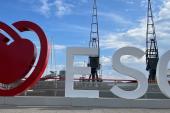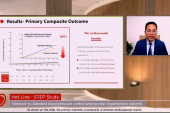New ESC Guidelines on BP and Hypertension Shift Treatment Targets Lower
The recommendations, based on STEP, CRHCP, and ESPRIT data, are now more in line with US guidance.

The European Society of Cardiology (ESC) has released updated guidelines for the management of patients with elevated blood pressure and hypertension.
In doing so, the writing committee made 57 new recommendations and moved from a seven- to a three-category classification system, creating the new intermediate group of patients with “elevated” BP (120-139/70-89 mm Hg in the office) for whom the risk of cardiovascular disease is increased and medication might be warranted.
The definition of hypertension remains at an office BP ≥ 140/90 mm Hg but the guideline writers lowered the systolic treatment target range for these patients to 120-129 mm Hg, representing a large change from the 2018 ESC/European Society of Hypertension (ESH) and 2023 ESH iterations but bringing them more in line with the 2017 US guidelines.
“We're fortunate and grateful in the hypertension world to have had more trials come to publication in the last few years, and there's been increased momentum and excitement around hypertension research that maybe wasn't there a decade or so ago,” writing committee co-chair John McEvoy, MBBCh (University of Galway, Ireland), told TCTMD. “The evidence has been accumulating, and that accumulation has sped up in the recent years, so we're happy to have the opportunity to synthesize that evidence with this new guideline.”
He acknowledged a “contrast” to prior European guidance with “a more intensive treatment target” as well as an emphasis on out-of-office measurements. McEvoy likened the new paradigm to “an opt-out approach, [in that] we say try to achieve a 120 to 129 target in the first instance and you can opt out if the patient isn't tolerating that treatment or can't achieve that target,” he said. “We're trying to think of ways to overcome physician and patient inertia around treating blood pressure. And we think that the evidence supports this approach.”
Presenting on the guidelines during the meeting, Richard McManus, MBBS, PhD (University of Oxford, England), said they “represent an evolution rather than a revolution.” Also, he added, “these more simple categories will help us in our daily practice.”
The guidelines, published in the European Heart Journal and presented at the ESC Congress 2024 last week, reference evidence from several new studies, primarily STEP, the China Rural Hypertension Control Project (CRHCP), and ESPRIT.
‘ALARA’ Treatment, Lifestyle Recommendations
The document places a focus on risk assessment and treatment of appropriate patients to the new targets, but acknowledges that some patients cannot tolerate intensive treatment, allowing for treatment to a systolic BP level as low as reasonably achievable (ALARA; class I, level of evidence A). While many of the new targets are noted as in-office measurements, the guidelines place an emphasis on out-of-office measurements due to the predilection for “white-coat hypertension” as well as masked hypertension (class I, level of evidence B).
It also introduces new recommendations related to lifestyle changes designed to lower BP, such as physical activity (moderate-intensity aerobic exercise ≥ 150 minutes/week; class I, level of evidence A) and reducing alcohol and sugar intake (both class I, level of evidence B).
Renal denervation, for the first time, received a mention in the European guidelines. While it is not recommended as a first-line BP-lowering intervention for hypertension or for those with moderately-to-severely impaired renal function, denervation was given a class IIb (level of evidence B) recommendation for use at medium-to-high volume centers for patients with resistant hypertension and uncontrolled BP despite being on three drugs. It was also given a class IIb (level of evidence A) recommendation in patients both at increased CVD risk and uncontrolled hypertension on fewer than three drugs.
The guidelines specify recommendations for subgroups such as young adults, pregnant people, and those who are frail. It also calls for patient-centered care, including informed discussion, home BP measurement, self BP measurement, and “safe task-shifting away from physicians” (all class I).
That last one is perhaps the most profound in the whole paper, McEvoy said. “It's something that I worry might get lost in our document, but actually could ultimately be, if implemented, one of the more important recommendations,” he said. “We know from the barbershop study, we know from the case studies in the US, we know from the Chinese rural hypertension project, [and] we know from Kaiser Permanente that if we can spread the load of management of hypertension, take tasks away from busy clinicians, that we can improve outcomes.”
The self-monitoring is also going to be key to improving BP control across the board, McManus said. “It helps with acceptance for patients of their disease, allows them to see the variation in blood pressure from day to day, empowers them, and helps in terms of adherence,” he said. “The evidence at the moment for using apps and so on over and above self-monitoring alone is less strong, but for many of us, that's a convenient thing to do. And so that is included for the first time in this guidance as a possibility.”
Embracing Renal Denervation
The renal denervation recommendations are based on evidence from several sham-controlled studies, including SPYRAL HTN-OFF MED, REDUCE HTN: REINFORCE, SPYRAL HTN-ON MED, SYMPLICITY HTN-3, and RADIANCE-HTN SOLO.
“Renal denervation now has very strong evidence for blood pressure-lowering efficacy,” McEvoy said. “It's conclusive at this point with the newer iterations of renal denervation catheter technology, including ultrasound and radioablation. So, it is important to have that option on the table for physicians and patients to consider in the treatment of their high blood pressure.”
However, where this treatment should be positioned in the “cascade” of options was tricky, he admitted. “We have numerous generic medicines that are effective and the evidence, while strong for blood pressure-lowering with renal denervation, hasn't necessarily gotten to the point where there's convincing evidence, certainly in a trial setting, for cardiovascular disease benefits,” McEvoy said. “For such a costly procedure, [clinical trial data] would be the type of evidence that we would need to see to move this more front and center.”
Commenting to TCTMD, Paul K. Whelton, MD (Tulane University School of Public Health and Tropical Medicine, New Orleans, LA), who served as writing group chair for the US recommendations, agreed that the evidence has finally mounted enough in favor of including renal denervation in the guidelines. “In the past, there just wasn't enough information, reliable and accurate information, to warrant a recommendation for renal denervation,” he said, noting that the intervention was included in the 2023 ESH guidelines. Whether the American guidelines will embrace this technology will be revealed next year, as an updated guideline is “anticipated in 2025,” Whelton added.
Joseph Ebinger, MD (Smidt Heart Institute at Cedars-Sinai, Los Angeles, CA), who also commented on the guidelines for TCTMD, said increased usage of renal denervation will not only reduce BP in patients who need it, but will “likely reduce pill burden, which I think is equally important.”
Going forward, he continued, “as the technology improves, renal denervation will become more efficacious. I still think we're at a point where it is most beneficial to individuals who have resistant-to-refractory hypertension or who are unable to tolerate medication. So I think the guidelines got it right and that this is not a first-line therapy, but it is a useful tool for individuals who continue to struggle with elevated blood pressure despite optimal lifestyle changes and aggressive pharmacotherapy.”
Concordance Across Societies
As for why the latest iteration of the ESC guidelines did not include the ESH, McEvoy did not go into specifics but instead said “the European Society of Cardiology has a well-defined process of producing guidelines . . . and there are some instances where other societies don't necessarily match the criteria that the ESC have in place for all their guidelines, not just for the hypertension guidelines.”
But several people who spoke with TCTMD for this story identified a closer match of the ESC guidelines with those of American societies.
“I'm actually really excited to see the fact that there's gaining consensus in both Europe and the United States of recognizing the importance of lower blood pressure thresholds,” Ebinger said. “In the last number of years, there's been an increasing amount of evidence that has demonstrated that lower blood pressure thresholds do really improve cardiovascular health [over the] long run and we start to see the increased risk of high blood pressure starting as low as 120 mm Hg and some would argue even lower. Seeing target thresholds and recommendations for clinicians to target a lower value I think is going to provide long-term benefit for the population overall.”
Whelton agreed, calling the bulk of the new ESC recommendations “essentially the same” as those in the US guideline. “There’s definitely less disparity now.”
However, he said, “traditionally, we have ascribed the term hypertension to the category of blood pressure at which you introduce antihypertensive medications,” which differs from what the Europeans have done by using different treatment and target thresholds. “I've never understood how you say you're going to treat to a certain level . . . but you're not going to categorize them as hypertensive,” Whelton continued. “It's curious. It's certainly different than our traditional thinking about when to use the designation hypertension.”
Regardless, these thresholds are “arbitrary” and can vary over time and by region, he said. “I would put more focus on the recommendations for treatment because that's really what clinicians do.”
In this regard, Ebinger said the guidelines “did a very good job of recognizing that a lot of these decisions are based on risk, and so for almost all individuals, they say, once you're starting therapy, you should target a blood pressure systolic goal of 120 to 129.”
Further, he continued, “I was pleasantly surprised to see them push the thresholds down more. I think that there's still a little way to go to get us all the way on the same page. . . . I think that as the trend continues, we're going to see the US and the European guidelines continue to converge as we move forward.
Odds and Ends
A couple other highlights or missed opportunities stood out in the comprehensive document.
Ebinger pointed out that the ESH guidelines gave an “opportunity for beta-blockers to be used as first-line therapy and here in the updated ESC guidelines, they've kind of moved it and said really just use them in combination with other first-line agents if there's a compelling reason.”
For Ramon C. Hermida, PhD (University of Vigo, Spain), the inclusion of office BP measurements at all is “improper” for identifying hypertension and associated cardiovascular risk. “My question is why the guidelines in 2024 are still recommending using something that does not work,” he told TCTMD, adding that nighttime blood pressure measurements alone should be used to determine these diagnoses. “In terms of the definition of hypertension and identification of people in need of treatment, this document is absolutely based in information from the last century.”
McEvoy doubled down on the inclusion of out-of-office BP measurements in the guideline. “We really emphasize them, if possible, over office blood pressure readings,” he said. “Nighttime blood pressure readings are, of course, known to be prognostically significant, and may point towards etiologies of the high blood pressure that may be treatable. . . . If anything, I think we've moved closer to getting that information than prior documents.”
Yael L. Maxwell is Senior Medical Journalist for TCTMD and Section Editor of TCTMD's Fellows Forum. She served as the inaugural…
Read Full BioSources
McEvoy JW, McCarthy CP, Bruno RM, et al. 2024 ESC guidelines for the management of elevated blood pressure and hypertension: developed by the task force on the management of elevated blood pressure and hypertension of the European Society of Cardiology (ESC) and endorsed by the European Society of Endocrinology (ESE) and the European Stroke Organisation (ESO). Eur Heart J. 2024;Epub ahead of print.
Disclosures
- Whelton and Ebinger report no relevant conflicts of interest.





Comments